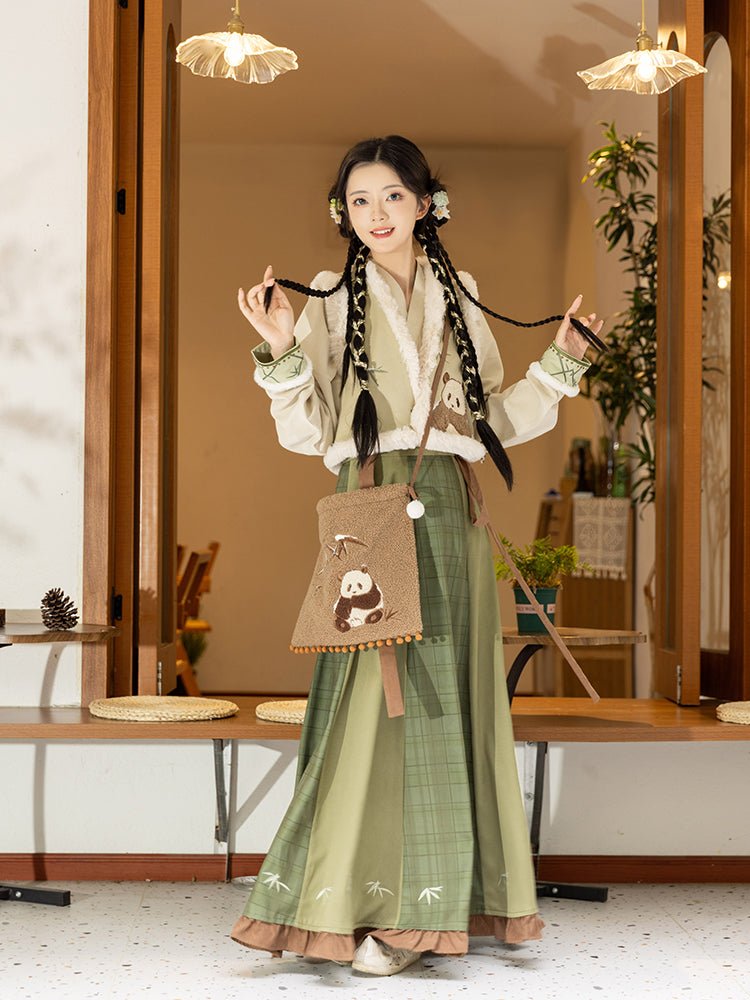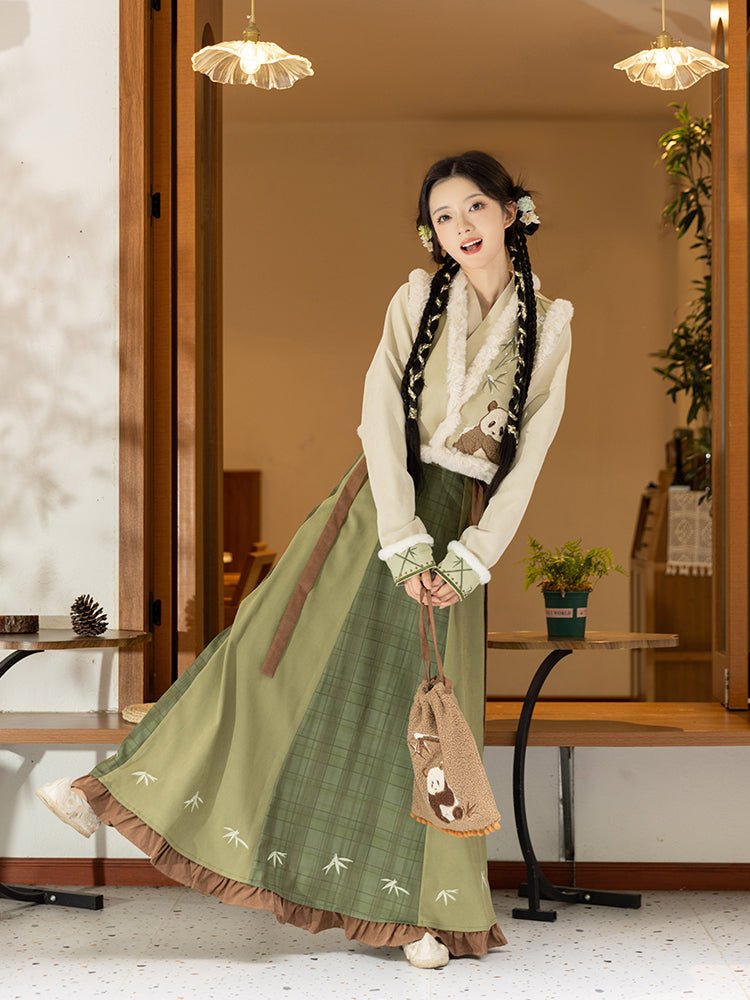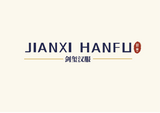The system of Tang Dynasty women's Hanfu (618-907 AD) combined traditional ritual norms with inclusive cultural traits, absorbing Hu-style elements while preserving Hanfu's essence—this integration is well-documented in The New Book of Tang: Records of Chariots and Costumes. It had three core styles reflecting social roles and daily needs:
1. Ruqun (Core Style of Tang Women's Hanfu)
As the most common style, Ruqun consisted of a short jacket ("ru") and a long skirt ("qun"). The ru had diverse collars (cross-collar, front-opening) and sleeve widths: narrow sleeves (Hu-influenced) for commoners’ daily work, wide sleeves for nobles’ elegance. The qun often used "po qun" (segmented skirt) design for fullness; nobles wore silk skirts in bright hues (crimson, emerald) with gold embroidery, while commoners used linen in plain white/gray.
2. Banbi (Casual Outer Garment)
A short-sleeved (elbow-length) outer wear, Banbi paired with Ruqun. Its compact design (Hu-style origin) suited daily activities like weaving, favored by both nobles and commoners. Nobles chose thin silk, commoners coarse cloth.
3. Pibo (Essential Accessory)
A lightweight silk scarf, Pibo draped over shoulders. Nobles used brocaded Pibo for ceremonial occasions, commoners plain ones for daily wear—adding grace to the ensemble.
Overall Characteristics
-
Hierarchical distinction: Fabrics/colors signaled status (silk vs. linen, bright vs. plain).
-
Han-Hu integration: Narrow sleeves, Banbi reflected cultural openness.
-
Practicality & ritualism: Daily styles (Banbi-Ruqun) met needs, while embroidered Ruqun served ceremonies.
About this Tang Dynasty Women's Winter Hanfu
Who injected a cute soul into the Tang Dynasty Women's beizi (outer garment) for autumn and winter? It’s the adorable national treasure of China — the panda. This Tang Dynasty-style Hanfu takes brown-toned pandas as the eye-catching highlight and matches them cleverly with gray-green hues, being both sweet and cute while brimming with autumn and winter vibes.
Beizi: It uses woolen fabric with plush lining, and the edges are trimmed with brown fur strips, firmly capturing the warm texture of autumn and winter. Under the bamboo branches, pandas are dotted with tiny snowflakes, creating a beautiful winter scene; the embroidery of pandas and bamboo adopts the three-dimensional appliqué embroidery technique with plush fabric, doubling both the texture and cuteness.
Cross-collar shirt: Made of soft fabric, a circle of plush decorates the cuffs, full of winter warmth.
Eight-panel skirt: It uses soft and skin-friendly twill brushed fabric, with bamboo patterns embroidered on the hem. The skirt hem adopts a hand-made lace design, adding a touch of fairy charm to the whole.
Panda purse: Made of soft teddy fleece fabric, the bag is embroidered with the cute pattern of a panda eating bamboo, which is lovely and full of fun.
Finishing Touches with Tang Dynasty Hanfu Accessories: Details Define the Atmosphere
-
Pibo: Choose one in the same color (with different saturation) as the skirt or a contrasting color. It is about 2 meters long and draped naturally over both arms, which can modify the figure and add linear beauty.
-
Headpieces: For basic styles, use buyao (tasseled hairpins), chāi (hairpins), and zān (hairpins). In the Flourishing Tang period, you can style the wōduò jì (sloping bun) with gold ornaments; for formal occasions, add phoenix hairpins and pearl buyao.
-
Hanfu Shoes: Match them with “embroidered upturned-tip shoes”, with pearls or gemstones embellished on the shoe tips to echo the overall sense of luxury.
-
Atmosphere-enhancing Items: Holding a hand fan (round fan) or a palace lantern and wearing a jade waist belt can instantly create a classic atmosphere.
About The Brand: 池夏
A Treasure Trove for 2.6 Million Hanfu Enthusiasts
✅ Diverse Silhouettes + Themed Bestsellers:From Ming-style square-collar horse-face skirts to Tang-style round-collar robes, Song-style beizi jackets to Jin-style ruqun dresses, covering both traditional forms and modernized designs. Must-have collections include the poetic color palettes of the 24 Solar Terms series, the classical narratives of Twelve Beauties of Jinling, and the viral Persimmon Fish Luck horse-face skirt (the same style showcased at the Dubai Expo!) and the ethereal Pink Mist modern Hanfu—perfect for daily commutes, photo shoots, or ancient-style gatherings.
✅ Design Highlights:Ditching bulk and rigidity, we use fresh color schemes (low-saturation Morandi, gentle macaron hues) and light tailoring to make Hanfu "breathable fashion". For example, summer styles adopt tencel and cotton fabrics, breathable and sweat-free, ideal for work or school!
💰 Student-friendly prices:80% of products are priced at $38–$108! A Ming-style short jacket + horse-face skirt set costs under $108, and a Tang-style tanling two-piece can be yours for $78—more affordable than a cup of coffee for a touch of Chinese elegance!
✨ Upgraded quality:In recent years, we’ve frequently launched skin-friendly fabrics like cotton-linen and tencel, with continuously optimized embroidery (just check the customer reviews—detail-oriented fans will find their favorites!)
📊 Hardcore data:Total platform sales exceeded $14 million in 2020 (RMB 100 million), and monthly sales in 2025 rank second in the Hanfu category (only after Shisanyu)! The single item Dream in the Garden: Jade Fragrance Snow sold 1,289 pieces monthly—our warehouse is constantly busy packing, proving popularity equals quality!
🌟 Rave reviews:
・"Bought 10+ sets— the pink of Furong Daughter is so delicate! I became an ancient beauty in seconds, and my friends kept asking for the link!"
・"Fabric exceeded expectations! The tencel beizi jacket for summer is incredibly breathable—colleagues at work kept asking where I bought it!"
・"Strong cultural vibe! The small designs in the Solar Terms series are so charming—wearing Hanfu makes me a fashion trendsetter!"
Here, tradition isn’t distant— it’s tangible Chinese romance. Whether you’re a Hanfu newbie looking for your first piece or a veteran enthusiast seeking daily-wear styles, Chixia’s "affordable yet quality" designs show that Han elements aren’t just for stages—they can go to cafes, classrooms, and become little joys in life. With 2.6 million fellow lovers choosing us, aren’t you ready to unlock your first Han-style beauty?














